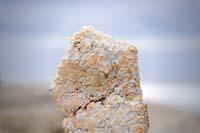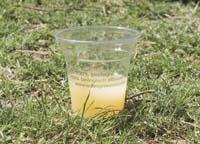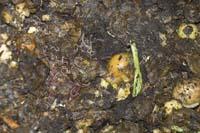Done and undone by the living
2009/02/01 Lakar Iraizoz, Oihane - Elhuyar Zientzia Iturria: Elhuyar aldizkaria

Plastics are light, economical, easy to adapt, etc. In addition, they are highly resistant to corrosion and various chemical agents. Therefore, today we use them for anything. Check the area and you will find yourself surrounded by plastic: your toothbrush is plastic, the sole of your shoes, your phone, some of the elements of the vehicle you use to move...
However, the advantages that these products offer while available become obstacles when we stop using them. And very few plastic products have a shelf life of more than 25 years--and we discard them long before. They are so resistant that they accumulate and accumulate in landfills.
Two ways are being used to solve the problem of plastics in landfills. One of them is recycling. As a concept it does not seem a bad solution to the problem. Currently, however, only a small proportion of plastic waste is recycled. It is not possible to determine this proportion, there is a great dance of figures from one source to another, but all are quite a distance of 50%.
They also burn plastic waste, which releases a lot of energy by burning it and uses this energy as an energy source. However, in addition to energy, combustion of these plastics eliminates high-grade compounds of toxicity.
The biodegradable plastics industry is moving forward in solving these environmental problems from conventional plastics. In some way it is intended to replace conventional plastics with biodegradable plastics. In other words, plastics with similar performance are being produced, but when they are no longer useful they degrade or disappear.
In addition, another aspect that drives the removal of conventional plastics is the reduction and the increase in oil prices. In fact, traditional plastics have a petrochemical origin. For the manufacture of biodegradable plastics it is not necessary to use oil.

Food of the living
The products we classify as plastics are made of different structures and types of materials. They all have a common characteristic: they are made of polymers. Polymers are long chains of repetitive units. Thus, polymers are the backbone of plastics.
Units that form polymer chains, monomers, can be obtained in different ways. The most commonly used polymers are petroleum compounds. Both the monomers of these polymers and the links they hold together to the monomers are very resistant in nature to the agents responsible for their degradation.
Degradation can be done in many ways. In short, degradation is the loss of physical and mechanical properties inherent in a material. For example, it can be done through light (known as photodegradation), water (when water breaks the bonds of a component) or the activity of living beings (it would be biodegradation).
For a certain material to be biodegradable, its components must be a source of nutrients for microorganisms, bacteria, algae or fungi. Decomposition is that microorganisms remove components by ingestion.
In the case of plastics, they first cut the long polymer that forms the plastic, obtaining smaller parts. In this way, the parts of plastics are getting smaller and smaller enough for microorganisms to eat directly. Once consumed, only carbon dioxide or methane and water remain.

Generation of biodegradable polymers
Many of the biodegradable plastics currently used come from natural components. Polymer sources for the manufacture of biodegradable plastics are mainly two: some of the compounds that contain plants, such as starch, and the components that microbes produce by fermentation.
Many plants produce starch as an energy deposit, and starch is actually a polymer. Actually, a polymer is not, but is formed by two polymers: amylose and amylopectin. Although there are two polymers, both have the same molecule as a monomer: glucose.
What happens is that glucose molecules come together differently, allowing the formation of the two polymers cited. Therefore, to sum up, we can say that starch is a long chain of glucose molecules, and of course, glucose can be a source of energy for many living beings.
In addition to those extracted from plants, biodegradable polymers are obtained from compounds that accumulate microorganisms during fermentation. Some of them are polymers called PHA or polyalkaloates. Some bacteria accumulate them as reserves of energy and carbon, and through them produce some biodegradable plastics.
On other occasions, living beings do not directly create polymers, but the monomers needed to artificially produce certain polymers. This is the case of polylactic acid or PLA polymer. Certain microorganisms produce lactic acid during fermentation. In the biodegradable plastics industry, lactic acid molecules bind together artificially forming a chain called polylactic acid.

Since this polymer is not generated spontaneously in nature, they consider it synthetic, since human intervention is fundamental to achieve it. Despite being synthetic, it is still biodegradable, since polylactic acid is basically lactic acid, and lactic acid can be a source of energy for different living beings.
Not all synthetic biodegradable polymers are obtained by renewable means. Some have petrochemical origin, but its structure allows the decomposition of several microorganisms.
Significant progress in some industries
Interest in biodegradable materials has been growing in recent years and the number of biopolymers generated has increased considerably in order to replace conventional plastics. Thousands of such products are patented annually.
The Institute of Plastic Technology AIMPLAS conducted a study to know the state of biodegradable polymers in general. To know the general state, aspects such as the economic status of biodegradable polymers, the new applications for biodegradable polymers, the regulations created in this regard, etc. were analyzed.
To know the economic situation, we reviewed the evolution of the production of biodegradable plastics in recent years, the price, etc. So you can know whether or not it is a booming activity.

The result was affirmative, since all aspects analyzed indicated that the industry is booming and that it will continue in that line: the demand for biodegradable polymers has increased, the production capacity, the price has decreased quite, etc.
In order for a certain technology to reach the market and evolve economically, research is essential. Therefore, the analysis of the state of research in biodegradable plastics allows us to know where the market will evolve in the future when the topics covered are implemented in the industry.
According to the AIMPLAS study, over the last twenty years there has been a steady increase in the number of research on biodegradable plastics. In the last ten years, for example, it has doubled. The United States, Japan and China are the countries that have done the most studies.
To find out what enters the study industry, experts turn to patents. In short, they protect the findings of research through patents for marketing. The study conducted by AIMPLAS found that the industries that have obtained the most patents in relation to biodegradable polymers are medicine, agriculture, the packaging industry and the transport industry.
Long way ahead
The advancement of the biodegradable plastics industry does not mean, however, that it can compete with conventional plastics. For example, currently available biodegradable plastics could not replace a small part of the uses offered by conventional plastics. And while the price of biodegradable plastics has partially declined, it is still much more expensive than conventional plastic.

In fact, the most powerful weapon of biodegradable plastics versus other conventional plastics is that they are much more environmentally friendly. However, we cannot think that the largely elimination of conventional plastics would forever end our environmental damage to plastics.
Because our biggest problem is that we use too much plastic. A European consumes an average of 100 kilos of plastic in a year. Suppose all the plastic we use now is made from renewable raw materials, such as starch extracted from potato. Think about the amount of land we would need to plant all the necessary potato, the amount of resources we would need to grow, the amount of water and energy we dissipate from taking the potato to getting a clean plastic product, etc...
Therefore, encouraging the production of biodegradable plastics is fine, but it would be much more beneficial to the environment if you were used to using less...


Gai honi buruzko eduki gehiago
Elhuyarrek garatutako teknologia



